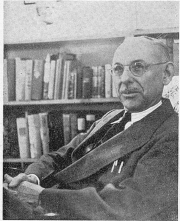1948-1951
Merrill BERNARD

President of the International Association of Hydrology
Mr. Merrill Bernard was born in Burlington, Iowa on July 25, 1892. In the course of his education, he attended the North Carolina Military Academy, the Military College of South Carolina, and the Agricultural and Mechanical College of Oklahoma. During World War I he held a commission of First Lieutenant in the United States Army.
Following his discharge from the Army in 1918, Mr. Bernard followed a non-governmental professional career in civil and hydrologic engineering, conducted chiefly in Louisiana, Texas and Central America, after which he was engaged in working government associations with the Mississippi Valley Commission. U.S. Geological Survey and Soil Conservation Service.
Mr. Bernard joined the Weather Bureau on March 5, 1937 as Chief of the then River and Flood Division servicing in this capacity until 1939, at which time he was appointed Hydrologic Director. In July 1946, there was formed the Division of Climatological and Hydrologic Services, in which he served as Chief until his death on April 13, 1951.
Om addition to his membership in the American Society of Civil Engineers, he held memberships in a large number of engineering, geographical and scientific organizations, both national and international, including the American Geophysical Union, the Washington Academy of Sciences, The American Association for the Advancement of Science, the American Meteorological Society, the International Meteorological Organization and the International Association of Hydrology, IUGG. He served as a member of the American delegation and the American Meteorological Mission to the Soviet Academy of Sciences in 1945 and 1946.
His many contributions in the fields of hydrology and meteorology are notably important for the success in clarifying the relationship between these two sciences. In addition to his paper, ‘Primary Role of Meteorology in Flood Flow Estimating’ for which he American Society of Civil Engineers honoured him with that Society’s award of the Norman Medal in 1945, perhaps his most distinctive single contribution consisted in his development of the Distribution Graph as a continuation of the work of LeRoy K. Sherman with the Unit Graph for predicting quantities and rates of basin runoff from known causative rainfall.
While his official contributions to his profession and the public welfare are indestructibly established, he will be remembered equally for the many personal traits that endeared him to his friends and associates. His career was marked throughout by the characteristics that reveal the man and explain his success. He had about him, in notable degree, and enthusiasm that inspired his associates and found obstacles intolerable, an imagination that made a joy of planning, and an energy that forced achievements from his projects. His skill at organization was a skill of action. His widely recognized abilities and professional prestige, combined in action with his personal likability and unvarying loyalty, gained for the Weather Bureau a great many advantages in its work with other government agencies. Many minor projects of public benefit and value, developed under his direction are now in continuing operation.
